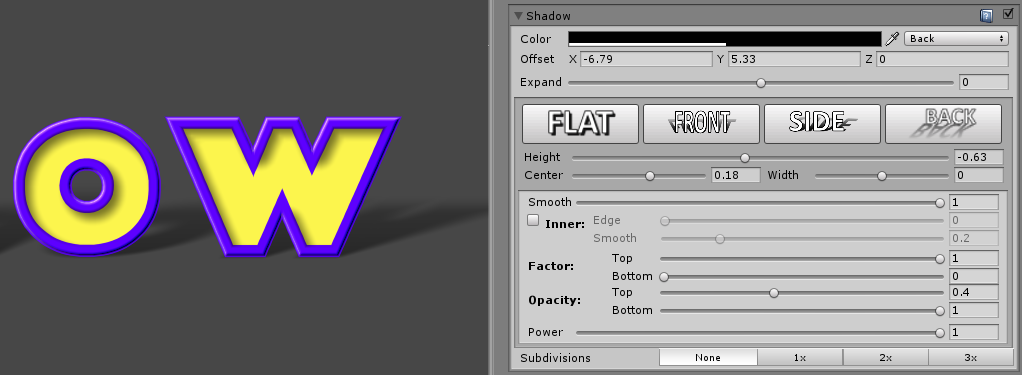Drop shadow are normally used to simulate 3D depth in a 2D image.
This is done by creating an offset shadow behind an object to indicate that the object is hovering above the background in 3D space.
Smart Edge exposes lot of parameters to tweak and deform the shadows. Allowing effects from standard flat shadows to perspective shadows that become softer with the distance.

Basic Controls
Color |
The Color of the Shadow. Normally black, but can be any other color to transform the shadow into an extra outline, ghost effect, etc. |
Position |
Can be "Simple" or "Back". Simple: Creates a Flat Offset Shadow that doesn't generate new geometry. This is the fastest mode Back: Generates a geometry to allow deforming the shadow and allows more controls and features
|
Offset |
How many pixels the shadow is displaced in each Axis. |
Expand |
When Expand is 0 the shadow will have the same width as the shape edge. Lower values make thiner shadows while higher values make them wider. |
Deformations
Shadows can be deformed to create perspective shadows. That simulates the Text or Image been on top of a surface.
Smart Edge comes with four shadow presets. By clicking any of this buttons, the Deformation Controls are automatically modified to show a shadow matching the preset. After that, you can freely tweak the effect by adjusting the values.

Height |
How big the shadow is. |
Center |
The top of the shadow is displaced to the left or right by using this value. |
Width |
How much the top of the shadow is expanded or contracted. |
Smoothing
The shadow can be sharp or blurred by changing the smoothing sliders.
Smooth |
How soft the shadow fading is going to be |
Inner |
When enabled the shadow will be hollow. Simulating the effect of only casting shadow from the character's edge
|
Edge |
The width of the edge that casts the shadow |
Smooth |
How smooth should be the inside shadow |
Top Factor |
Smoothness at the top of the shadow. 0 makes it sharp while 1 makes it use the Smooth value
|
Bottom Factor |
Smoothness at the bottom of the shadow. |
Top Opacity |
This controls how transparent the top of the shadow is. |
Bottom Opacity |
The transparency at the bottom. Placing different values for the top and bottom provides the illusion of the shadow fading out. |
Power |
This defines how fast the smoothness fades the shadow. |
Subdivision Controls
Sometimes the shadow projection gets deformed because of how the texture is mapped on the triangles. To reduce the distortion artifacts, the polygons can be subdivided.
Adding more subdivisions can degrade performance. However, in most circumstances it wont make a difference given than most mobile devices and computers are good at processing geometry as far as they are batched together.
Created with the Personal Edition of HelpNDoc: Create help files for the Qt Help Framework